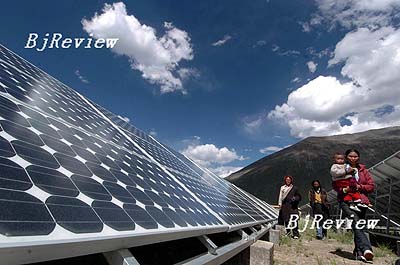|

In June 2005, a public service announcement for car drivers started to appear on Chinese television. It told people, "For our blue sky, please drive one less day per month." In August 2007, the announcement changed into: "For our Green Olympics, please drive one less day per week."
The State Council also issued a set of standard temperature controls for air conditioners, which stated that in summer the temperature in a building equipped with central conditioners should not be below 26 degrees Celsius; and in winter should not be above 20 degrees Celsius.
Efforts to reduce emissions can be seen in every Chinese family and every corner of the country. The changes show China's firm stance on emission reduction and environment protection.
The difference ordinary people can make was demonstrated when experts calculated that if every person in Beijing drove one day less per month, Beijing's total vehicle emissions would decrease by more than 44,000 tons a year. If every driver in China did that, the country's total carbon dioxide emissions would fall by 1.22 million tons every year, with 554 million liters of oil saved.
Since signing the Kyoto Protocol, an international treaty designed to limit global greenhouse gas emissions, in 1998, the country has been making efforts to fulfill its promise to the treaty, by taking measures to save energy and reduce pollution discharges. In 2003, China confirmed its Scientific Outlook on Development, according to which, a goal of realizing sustainable development is stressed. Two years later, China brought up the concept of building a resource-saving and environment-friendly society.
In 2006, the Chinese Government set a goal to reduce energy consumption per unit of gross domestic product (GDP) by 20 percent and major pollutant discharges by 10 percent in the 11th Five-Year Plan, which runs from 2006-10.
"China has taken a series of policies and measures to address climate change in the overall context of our national sustainable development strategy and outstanding achievements have been made," said Xie Zhenhua, Vice Minister of China's National Development and Reform Commission, at a forum sponsored by the Center for Clean Air Policy in Washington, D.C. in September 2007.
Xie introduced China's achievements on emission reduction. He said China's renewable energy had reached 166 million tons of standard coal equivalent in 2005, which equals a discharge reduction of 380 million tons of carbon dioxide. From 1980 to 2005, China's forest protection and tree planting helped to decrease carbon dioxide emissions by over 5 billion tons. China has implemented birth control policies since the 1970s, leading to a population reduction of 300 million. Through this, China has reduced carbon dioxide emissions by 1.3 billion tons every year, Xie said.
China also mapped out its goals on energy efficiency and pollution reduction in the General Work Plan for Energy Conservation and Pollutant Discharge Reduction, which was issued on June 4, 2007, stating China's plan for saving energy and reducing major pollutant discharges by 10 percent by 2010. "We should make sure that the economy grows on the basis of energy and resource conservation and environmental protection," said the plan.
The State Council stressed that energy efficiency and pollutant discharge reduction should be set as indices for assessing economic and social development in all localities and the performance of government and company leaders.
That means company leaders will receive a negative performance assessment if they fail to reach the goals for energy efficiency and pollutant discharge reduction regardless of achievements in other fields.
"Greater efforts for efficiency and discharge reduction are urgently needed to deal with global weather change and it is a responsibility we should shoulder," according to the plan.
Experts suggested that, based on China's existing situation, two measures are practical. The first is to save energy and use the energy efficiently; and the second is to accelerate the development of clean energy and renewable energy resources.
However, being a developing country, China's efforts remain limited when dealing with this global problem. The UN-sponsored Kyoto Protocol expires in 2012, and China, as a developing country and a signatory of the protocol, believes post-Kyoto regulations should be part of the UN process, said Chinese President Hu Jintao at this years' G-8 summit.
On China's efforts to combat the effects of climate change, Hu said the government took the issue seriously and has adopted policies to reduce greenhouse gas emissions, even though its per capita carbon dioxide emissions are less than one-third that of developed countries.
Hu iterated China's stance on sustainable development and its principle of "common but differentiated responsibilities." "Developed countries should, acting in accordance with this principle, meet the emission reduction targets set in the Kyoto Protocol, provide assistance to developing countries and continue to take the lead in undertaking obligations to reduce emissions after 2012," he said.
|
Kyoto Protocol
The Kyoto Protocol is an international treaty designed to limit global greenhouse gas emissions. It was agreed at a UN conference in December 1997, in Kyoto, Japan, by 159 countries that are members of the 1992 UN Framework Convention on Climate Change (UNFCCC).
It commits the industrialized countries that have ratified it to reduce the amount of six greenhouse gases, namely carbon dioxide (CO2), methane (CH4), nitrous oxide (N2O), hydrofluorocarbons (HFCs), perfluorocarbons (PFCs) and sulphur hexafluoride (SF6).), by 5.2 percent of 1990 levels during the five-year period from 2008 to 2012.
|
|



